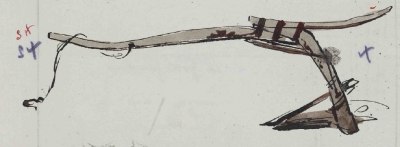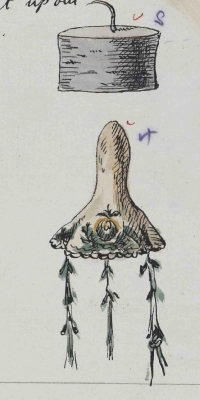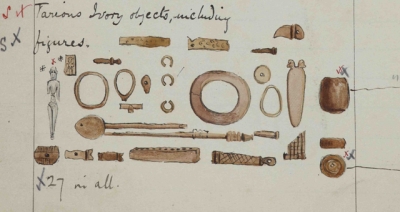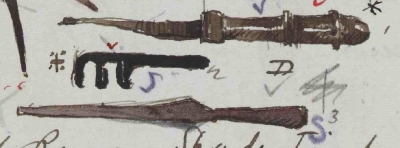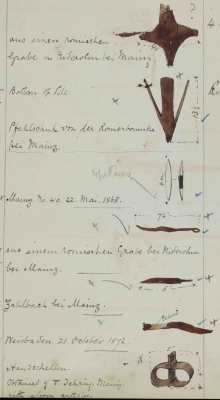To search the RPR site click here
Thanks to help from others we hope we have identified these objects:
Here are the images that have been identified, we are very grateful to our first correspondent for identifying one of our initial images only a day after this page was first created:
Ny Björn Gustafsson of Stockholm University says: ‘The objects in Add.9455vol1_p168 /1-4 are bronze sickles of a type used and produced in southern Scandinavia during the Bronze Age. A Swedish sickle in the collections of the Museum of National Antiquities, Stockholm can be seen here: http://mis.historiska.se/mis/sok/include_image_exp.asp?uid=212809
This object has been confirmed, by Roy Brigden of the Museum of English Rural Life, as an ard, a form of plough which turned the surface of the earth rather than turning furrows. He believes that this form of plough is likely to have been made and used in the tropics as it is much better suited to those local conditions. It is definitely not an English plough.
Elin Bornemann has suggested that this item is a stovchen, a little stove, used for keeping the teapot warm by heating with a small candle inside. These are used in the Netherlands and also in Germany. A similar item was also used to contain coals and used to heat the feet.
Note that in the fourth image there are two objects shown. The first entry on the page (illustration not shown) is described as 'Description of object: Objects presented by Lord Arthur Russell to General Pitt Rivers ... Wicker ladle with which the Neapolitan Street vendors of Maccoroni [sic] pick it up out of the boiler 16” L [Drawing] It is possible therefore that the items below it also came from Naples. However, regarding the second of the two images shown, Ollie Douglas of the Museum of English Rural Life, University of Reading suggests that it looks slightly reminiscent of a maiden’s garland. This English custom involved hanging paper or cloth ‘lantern’ shaped objects in the church following the death and subsequent burial of young unmarried women. Examples of such items were examined routinely by antiquarians and folklorists from Brand and Bourne onwards. They vary quite a bit in style. This item does seem to echo the form of some of these items. Many examples had paper gloves attached and often they contained some reference to the name of the deceased. Few were removed from churches though, so far as I can gather (although this did not stop some enthusiastic folklorists from trying!). See http://www.andrewspages.dial.pipex.com/matlock/church_gar.htm,http://www.maidensgarlands.com/, and http://www.wishful-thinking.org.uk/genuki/DBY/Ashford/Crant1.html for more details and some images. Rosie Morris has written a paper in Folklore about them. He adds, 'the image, however, simply appears to be somewhat reminiscent of them. I half wonder whether there is some odd custom local to Naples that involved garland style decorations of one kind or another.
Note that the first of the items shown is still mysterious.
This image has been identified by Dr Peter de Clercq, editor 'Antiquarian Horology' as a dragon-boat alarm. This is described on page 127 of the exhibition catalogue of 'The Story of Time' ed Kristen Lippincott (Merrell Holberton Publishers London in association with the National Maritime Museum, 1999) as
'An unusual use of the incense stick in China was for a time alarm or alarm clock. A special vessel was created that measured about two feet in length, cast in bronze or carved in wood. It was shaped with the body of a dragon representing the ancient Dragon Boats used in the traditional annual Chinese festival that continues to be celebrated to this day. The exterior of wooden examples was generally covered with black lacquer which was then painted with scales in gilt, and the head and tail also were rendered in gilt. The interior of the body of this highly decorated vessel was hollowed out and wire supports were inserted inside along its length. A long incense stick marked at intervals with the hours was placed upon the supports. This "Dragon Boat vessel," supported upon two wooden blocks was placed over a large flat copper or brass dish or platter. A thin string, usually of silk, having a small metal weight or bell attached at each end, was stretched across the top of the vessel at a point along the marked incense stick chosen by the sleeper when he wished to be aroused. The incense stick burned for the desired number of hours and when it reached the string, the string burned quickly and parted. As the small metal weights dropped into the dish, they made a brief tinkling sound, which presumably was sufficient to awaken the sleeper. [For a comprehensive history of the use of incense for time measurement in Japan see THE TRAIL OF TIME. Time Measurement With Incense in East Asia by Silvio A. Bedini (Cambridge: Cambridge University Press, 1999)].
Tom Hardwick suggests that the image of Add.9455vol1_p226, if a true single acquisition, are all Egyptian bone/ivory items. The figure on the left is clearly a Pre-dynastic figure. The piece immediately to the right is a Romano-Egyptian plaque like this piece in the Petrie Museum, London, (although probably with incised decoration inlaid with pigment, rather than carved in relief). The pieces on the top row are probably bone / ivory strips with concentric drilled decoration, like this piece in the Petrie. The long rectangular thing on the bottom row, with holes drilled into it, is a spacer bead like these in the Petrie. Ivory bracelets are common in Egypt, as are spoons and hairpins - is the thing above the spacer bead a spoon and hairpin drawn too close together?
Add.9455vol1_p24 /4-8: Tom Hardwick asks are two lids of 'funerary boxes' from Pharaonic Egypt? - the rightmost image showing a bird's eye view (top) and profile view (bottom) of one. These typically have an arched lid with projecting pillars in the corners, and can have concentric semi-circles painted on them (like the right hand one), and a column of inscription on the lid, as appears to be the case on the left hand image. These boxes often contain shabti figures, or can be model coffins. An example is shown here
We are very grateful to Valentin Boissonnas, Professeur chargé d'enseignement, Haute école de Conservation-restauration Arc, Neuchâtel for the following opinions:
Add.9455vol2_p.59/ 5-7:
The right side of the first object is certainly a cast copper alloy handle. The left part is probably an iron part that could be a blade or a tool such as a file etc. When iron and copper are in contact in the ground the copper is protected and well preserved, whereas the iron corrodes extensively. Thats what it looks like here.
The third object is a wrought iron spear point with the left side being the blade and the right side the hollow tube where the wooden spear would have been inserted. Roman.
Add.9455vol1_p199:
'from a Roma grave from Nieder-Olm near Mainz, Germany'.
The next one is an iron reinforcement from the bottom of a wooden pole that was part of a Roman bridge near Mainz.
Next one ??? Most likely a corroded wrought iron tool. Found in a Roman grave in Nieder-Olm near Mainz.
An iron knife blade missing the handle (originally made of wood that usually does not survive burial). 'Zahlbach near Mainz'
'Weisbaden'. Another wrought iron knife blade. I can't read the detail that designates the beige part, but it could be remains of a bone or wooden handle.
Add.9455vol4_p1319 /1 looks to me like a decorated sword sheath, maybe a fake or middle eastern curio. Definitively not Roman with those two ballerinas :)


